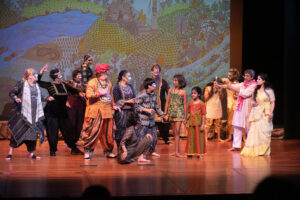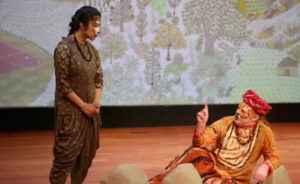
“In the original version the tiger is the bad guy. In ours he is not,” – Director Vinita Sud Belani
A blur of arms, hands and voices could be seen and heard in the basement living area of a Saratoga home. Rehearsals were in progress for EnActe Arts upcoming production of “The Jungle Book: Rudyard Revisited” which premieres on Sept. 30 evening at Cubberley Theatre in Palo Alto, California.
Directed by EnActe Arts co-founder Vinita Sud Belani and Noah Lucé, the play features music by George Brooks, choreography by Aparna Sindhoor and Anil Natyaveda, costumes by Oona Natesan, Madhubani artwork by Leenika Beri Jacob and Avinash Karn. The production also features guest artist and dancer Dr. Anita Ratnam, from India.
The Jungle Book was written by Rudyard Kipling, who was born in India and considered it home, despite his time in England. Kipling wrote the story after reading a news article about a young boy, Dina Sanichar, who was raised by wolves. The Enacte Arts production takes a new look at the text and imagines it in a very different way.
EnActe Art’s mission is to represent South Asian stories and voices by putting them in a global context. “I wanted us to be telling stories that we could reclaim because they had either been appropriated or colonized or you know, told incorrectly,” says Belani.
“The Jungle Book is a classic children’s tale told all over the globe – and now we are reclaiming that Jungle using authentic South Asian storytelling techniques, like our Madhubani painting and Indigenous costumes,” she says.
Associate Director Noah Lucé, who is also Manager of Education for the EnActe School of Drama underscores this point. “Kipling is an actual character of this, and he has to confront some of his past wrongdoing as he sees it to revise his tale. And I think that’s a really beautiful message to put out there that we can look at old texts and still find wonderful meaning in them. And also realize that from a modern lens, we can call out the issues of the past, but it doesn’t necessarily devalue the entire text.”
Pandemic Delays
Belani started this project in 2019 as part of the EnActe Conservatory program. Fourteen students, the youngest age 6 and the oldest 66 worked on the script together.
It was then workshopped and turned into a ciné play during the height of the Covid Pandemic. The Omicron variant caused further delays to the show’s premiere, “so this is our fourth attempt, and third production of the script.”
This rehearsal at Belani’s friend’s home was the first time many of the cast were meeting each other.
Dr. Anita Ratnam as Kaa
Sounds of the cast singing “the jungle law” reverberate up the basement floor staircase onto the patio where Dr. Anita Ratnam sits, partially dressed as Kaa, eyes rimmed in kohl. A long extension of her hair is wrapped in sparkly gold thread, emphasizing her snake-like movements.
“I think of Kaa as a really feminine character – and I decided that she is not going to be a python, she is going to be a cobra,” said Ratnam, speaking at the character development for Kaa. “Cobras are mystical, they are timeless, they are ancient, and they kind of link for us between the animal world and the spirit world. And in India, we don’t kill snakes.”
Unlike the Disney animated version of Kaa, which is what most people are familiar with, the Kaa in Kipling’s story and particularly in this revision has much more depth. “She actually saves Mowgli on more than one occasion from the tiger. And then she says ‘you have to choose what are you and who are you?’,” says Dr. Ratnam.
“I think that her role is both quiet but also very powerful. She opens the show and she ends the show. She has the first sound and then she has the last word.”
A Walk Through The Jungle
Dance and movement is a big part of the play and drives the story and character. “The choreography is totally integrated into the production, rather than just come and go,” says Aparna Sindhoor.
Kalarippayuttu, martial arts, bharatanatyam, folk dances and animal movements inspired the choreography, along with the music of George Brooks.
“We are kind of trying to embellish the movements with symbolic gestures of animals,” continues Sindhoor. “We make our own style of movement, using different techniques.”
Tiger Conservation
Part of reclaiming the narrative includes a collaboration with Dr. Krithi Karanth, Executive Director and Chief Conservation Scientist for Centre for Wildlife Studies in Bengaluru, India.
Belani was inspired by a talk by Dr. Karanth and her father on tiger conservation several years ago which sparked the idea of reimagining The Jungle Book. The show will be a fundraiser for the center. Dr. Karanth will be speaking at every show, and along with bringing books for children, there will also be an exhibit.
“In the original version the tiger is the bad guy, and in ours he is not,” said Belani.
“The Jungle Book: Rudyard Revised” adapted by EnActe Arts, directed by Vinita Sud Belani and Noah Lucé with music composition by George Brooks, premieres on Sep. 30 at Cubberley Theatre in Palo Alto, CA for a 3-day run. Further shows are scheduled for Houston, San Francisco and San Jose. Tickets available via EnActe Arts.
This story was produced in partnership with CatchLight and [ third party, if applicable ] as part of the CatchLight Local Visual Storytelling Initiative. To learn more about this collaborative model for local visual journalism, sign up for CatchLight’s newsletter.
Orginal article @ https://indiacurrents.com/the-jungle-book-as-youve-never-seen-it/







No comment yet, add your voice below!